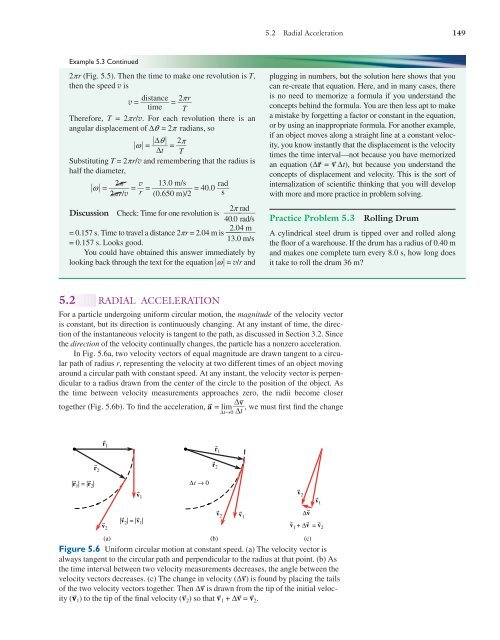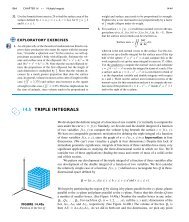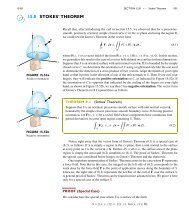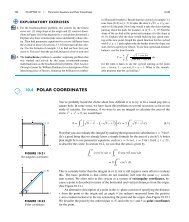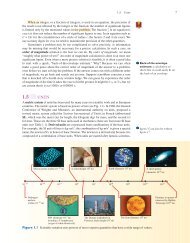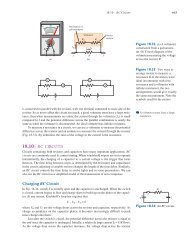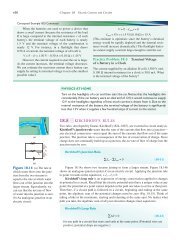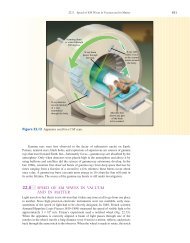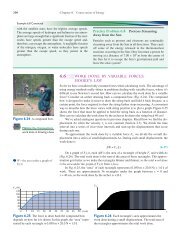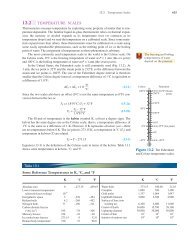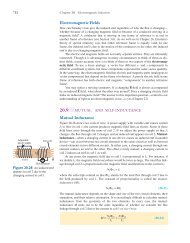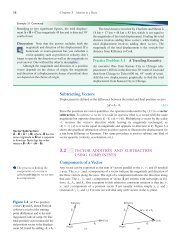RADIAL ACCELERATION
RADIAL ACCELERATION
RADIAL ACCELERATION
You also want an ePaper? Increase the reach of your titles
YUMPU automatically turns print PDFs into web optimized ePapers that Google loves.
5.2 Radial Acceleration 149<br />
Example 5.3 Continued<br />
2pr (Fig. 5.5). Then the time to make one revolution is T,<br />
then the speed v is<br />
v = di stan<br />
tim<br />
ce<br />
e<br />
= 2 pr <br />
T<br />
Therefore, T = 2pr/v. For each revolution there is an<br />
angular displacement of ∆q = 2p radians, so<br />
w = ∆ q<br />
∆<br />
t<br />
= 2 p<br />
T <br />
Substituting T = 2pr/v and remembering that the radius is<br />
half the diameter,<br />
2p<br />
w = = v 2p r/v<br />
r = 13.0<br />
m/<br />
s<br />
= 40.0 ra d<br />
(0.650<br />
m)<br />
/2 s<br />
<br />
2p<br />
rad<br />
Discussion Check: Time for one revolution is <br />
40 . 0 rad/s<br />
2.<br />
04<br />
m<br />
= 0.157 s. Time to travel a distance 2pr = 2.04 m is <br />
= 0.157 s. Looks good.<br />
1 3.<br />
0 m/s<br />
You could have obtained this answer immediately by<br />
looking back through the text for the equation w = v/r and<br />
plugging in numbers, but the solution here shows that you<br />
can re-create that equation. Here, and in many cases, there<br />
is no need to memorize a formula if you understand the<br />
concepts behind the formula. You are then less apt to make<br />
a mistake by forgetting a factor or constant in the equation,<br />
or by using an inappropriate formula. For another example,<br />
if an object moves along a straight line at a constant velocity,<br />
you know instantly that the displacement is the velocity<br />
times the time interval—not because you have memorized<br />
an equation (∆r = v ∆t), but because you understand the<br />
concepts of displacement and velocity. This is the sort of<br />
internalization of scientific thinking that you will develop<br />
with more and more practice in problem solving.<br />
Practice Problem 5.3<br />
Rolling Drum<br />
A cylindrical steel drum is tipped over and rolled along<br />
the floor of a warehouse. If the drum has a radius of 0.40 m<br />
and makes one complete turn every 8.0 s, how long does<br />
it take to roll the drum 36 m?<br />
5.2 <strong>RADIAL</strong> <strong>ACCELERATION</strong><br />
For a particle undergoing uniform circular motion, the magnitude of the velocity vector<br />
is constant, but its direction is continuously changing. At any instant of time, the direction<br />
of the instantaneous velocity is tangent to the path, as discussed in Section 3.2. Since<br />
the direction of the velocity continually changes, the particle has a nonzero acceleration.<br />
In Fig. 5.6a, two velocity vectors of equal magnitude are drawn tangent to a circular<br />
path of radius r, representing the velocity at two different times of an object moving<br />
around a circular path with constant speed. At any instant, the velocity vector is perpendicular<br />
to a radius drawn from the center of the circle to the position of the object. As<br />
the time between velocity measurements approaches zero, the radii become closer<br />
together (Fig. 5.6b). To find the acceleration, a = lim ∆ v <br />
,<br />
∆t→0 ∆ t<br />
we must first find the change<br />
r 1<br />
r 1<br />
r<br />
r 2<br />
2<br />
|r 1 | = |r 2 |<br />
∆t → 0<br />
v v 1 2<br />
v 1<br />
v 2 v 1<br />
∆v<br />
|v 2 | = |v 1 |<br />
v 2 v 1 + ∆v = v 2<br />
(a) (b) (c)<br />
Figure 5.6 Uniform circular motion at constant speed. (a) The velocity vector is<br />
always tangent to the circular path and perpendicular to the radius at that point. (b) As<br />
the time interval between two velocity measurements decreases, the angle between the<br />
velocity vectors decreases. (c) The change in velocity (∆v) is found by placing the tails<br />
of the two velocity vectors together. Then ∆v is drawn from the tip of the initial velocity<br />
(v 1 ) to the tip of the final velocity (v 2 ) so that v 1 + ∆v = v 2 .
150 Chapter 5 Circular Motion<br />
In uniform circular motion, the<br />
direction of the acceleration is<br />
radially inward (toward the<br />
center of the circular path).<br />
v 5<br />
v 6<br />
a 5<br />
a 1<br />
a 2<br />
a 6<br />
v 1<br />
v 2<br />
v 4<br />
a 4<br />
a 3<br />
v 3<br />
Figure 5.7 In uniform circular<br />
motion, the acceleration is<br />
always directed toward the center<br />
of the circle, perpendicular to<br />
the velocity.<br />
v 2<br />
∆q<br />
v1<br />
∆v<br />
Figure 5.8 The velocity vector<br />
sweeps out an arc of a circle<br />
whose “length” is nearly equal to<br />
that of the chord ∆v.<br />
in velocity ∆v for a very short time interval. Figure 5.6c shows that as the time interval<br />
∆t approaches zero, the angle between the two velocities also approaches zero and ∆v<br />
becomes perpendicular to the velocity.<br />
Since ∆v is perpendicular to the velocity, it is directed along a radius of the circle.<br />
Inspection of Figs. 5.6b and 5.6c shows that ∆v is radially inward (toward the center of<br />
the circle). Since the acceleration a has the same direction as ∆v (in the limit ∆t → 0),<br />
the acceleration is also directed radially inward (Fig. 5.7)—that is, along a radius of the<br />
circular path toward the center of the circle. The acceleration of an object undergoing<br />
uniform circular motion is often called the radial acceleration a r . The word radial here<br />
just reminds us of the direction of the acceleration. (A synonym for radial acceleration<br />
is centripetal acceleration. Centripetal means “toward the center.”)<br />
Magnitude of the Radial Acceleration<br />
To find the magnitude of the radial acceleration for uniform circular motion, we must<br />
find the change in velocity ∆v for a time interval ∆t in the limit ∆t → 0. The velocity<br />
keeps the same magnitude but changes direction at a steady rate, equal to the angular<br />
velocity w. In a time interval ∆t, the velocity v rotates through an angle equal to the<br />
angular displacement ∆q = w ∆t. During this time interval, the velocity vector sweeps<br />
out an arc of a circle of “radius” v (Fig. 5.8). In the limit ∆t → 0, the magnitude of ∆v<br />
becomes equal to the arc length, since a very short arc approaches a straight line. Then<br />
∆v = arc length = radius of circle × angle subtended<br />
= v ∆q = v w ∆t<br />
Acceleration is the rate of change of velocity, so the magnitude of the radial acceleration<br />
is<br />
a r = a = ∆ v <br />
= vw (w in radians per unit time) (5-11)<br />
∆t<br />
where absolute value symbols are used with the vector quantities to indicate their magnitudes.<br />
Velocity and angular velocity are not independent; v = w r. It is usually most<br />
convenient to write the magnitude of the radial acceleration in terms of one or the other<br />
of these two quantities. So we write the radial acceleration in two other equivalent ways<br />
using v = wr:<br />
a r = v 2<br />
r<br />
or a r = w 2 r (w in radians per unit time) (5-12)<br />
Note that Eqs. (5-11) and (5-12) are valid only when w is measured in radians per<br />
unit time (normally rad/s, but rad/min or rad/h would be correct).<br />
Example 5.4<br />
A Spinning CD<br />
If a CD spins at 210 rpm, what is the radial acceleration<br />
of a point on the outer rim of the CD? The<br />
CD is 12 cm in diameter.<br />
Strategy From the number of revolutions per minute,<br />
we can find the frequency and the angular velocity. The<br />
angular velocity and the radius of the CD enable us to<br />
calculate the radial acceleration.<br />
Solution We convert 210 rpm into a frequency in revolutions<br />
per second (Hz).<br />
rev<br />
1<br />
f = 210 × m in<br />
m in<br />
6 0 s<br />
= 3.5 re v<br />
s<br />
= 3.5 Hz<br />
For each revolution, the CD rotates through an angle of<br />
2p radians. The angular velocity is<br />
w = 2p f = 2p rad ians<br />
× 3.5 re v<br />
rev<br />
s<br />
= 7.0p rad/s<br />
Then using Eq. (5-11), the radial acceleration is<br />
a r = w 2 r = (7.0p rad/s) 2 × 0.060 m = 29 m/s 2<br />
Continued on next page
5.2 Radial Acceleration 151<br />
Example 5.4 Continued<br />
Discussion When finding the radial acceleration, use<br />
whichever form of Eq. (5-12) is more convenient. For rotating<br />
objects such as the spinning CD, it’s usually easiest to<br />
think in terms of the angular velocity. For an object moving<br />
around a circle, such as a satellite in orbit whose speed is<br />
known, it might be easier to use v 2 /r. Since the two equations<br />
are equivalent, either can be used in any situation.<br />
Practice Problem 5.4 Radial Acceleration<br />
of a Point on an Old Record<br />
What is the radial acceleration of a point 25.4 cm from<br />
the center of a record that is rotating at 78 rpm on a<br />
turntable?<br />
Now that we know the magnitude and direction of the acceleration of any object in<br />
uniform circular motion, we can use Newton’s second law to relate the net force acting<br />
on the object to the speed and radius of its motion. The net force is found in the usual<br />
way: each of the individual forces acting on the object is identified and then the forces<br />
are added as vectors. Every force acting must be exerted by some other object. Resist<br />
the temptation to add in a new, separate force just because something moves in a circle.<br />
For an object to move in a circle at constant speed, real, physical forces such as gravity,<br />
tension, normal forces, and friction must act on it; these forces combine to produce a<br />
net force that has the correct magnitude and is always perpendicular to the velocity of<br />
the object.<br />
Problem-Solving Strategy for an Object in Uniform Circular Motion<br />
1. Begin as for any Newton’s second law problem: identify all the forces acting on<br />
the object and draw a free-body diagram.<br />
2. Choose perpendicular axes at the point of interest so that one is radial and the<br />
other is tangent to the circular path.<br />
3. Find the radial component of each force.<br />
4. Apply Newton’s second law as follows:<br />
ΣF r = ma r<br />
where ΣF r is the radial component of the net force and the radial component of<br />
the acceleration is<br />
a r = v 2<br />
r = w 2 r<br />
(For uniform circular motion, neither the net force nor the acceleration has a<br />
tangential component.)<br />
Example 5.5<br />
The Hammer Throw<br />
An athlete whirls a 4.00-kg hammer six or<br />
seven times around and then releases it.<br />
Although the purpose of whirling it around<br />
several times is to increase the hammer’s speed, assume<br />
that just before the hammer is released, it moves at constant<br />
speed along a circular arc of radius 1.7 m. At the<br />
instant she releases the hammer, it is 1.0 m above the<br />
ground and its velocity is directed 40° above the horizontal.<br />
The hammer lands a horizontal distance of 74.0 m<br />
away. What force does the athlete apply to the grip just<br />
before she releases it? Neglect air resistance.<br />
Strategy After release, the only force acting on the<br />
hammer is gravity. The hammer moves in a parabolic trajectory<br />
like any other projectile. By analyzing the projectile<br />
motion of the hammer, we can find the speed of the<br />
hammer just after its release. Just before release, the<br />
Continued on next page
152 Chapter 5 Circular Motion<br />
Example 5.5 Continued<br />
forces acting on the hammer are the tension in the cable<br />
and gravity. We can relate the net force on the hammer to<br />
its radial acceleration, calculated from the speed and<br />
radius of its path. The problem becomes two subproblems,<br />
one dealing with circular motion and the other with<br />
projectile motion. The final velocity for the circular<br />
motion is the initial velocity for the projectile motion.<br />
Solution During its projectile motion, the initial<br />
velocity has magnitude v i (to be determined) and direction<br />
q = 40° above the horizontal. Choosing the +y-axis<br />
pointing up, the displacement of the hammer (in component<br />
form) is ∆x = 74 m and ∆y = –1.0 m (Fig. 5.9), the<br />
acceleration of the hammer is a x = 0 and a y = –g, and the<br />
initial velocity is v ix = v i cos q and v iy = v i sin q . Then,<br />
from Eqs. (3-11) and (3-12),<br />
∆x = (v i cos q ) ∆t and ∆y = (v i sin q ) ∆t – 1 2 g(∆t)2<br />
Solving the left equation for ∆t and substituting into the<br />
right equation gives<br />
∆x<br />
∆y = v i sinq – 1<br />
vi cosq<br />
2 g ∆x<br />
<br />
v i cos q 2<br />
After a bit of algebra, we can solve for v i . First we multiply<br />
through by 2v 2 i cos 2 q :<br />
2v 2 i cos 2 q ∆y = 2v 2 i cos 2 q ∆ x sin<br />
q<br />
– 2 v i 2 cos 2<br />
cos<br />
q<br />
q<br />
2<br />
g ∆x<br />
v c <br />
os i q 2<br />
Moving the first term on the right side to the left side and<br />
factoring out v 2 i ,<br />
v 2 i (2∆y cos 2 q – 2∆x cos q sinq ) = –g(∆x) 2<br />
Now we solve for v i :<br />
g(∆x)<br />
v i =<br />
<br />
2<br />
<br />
2∆x cos q sin q – 2∆y cos 2 q<br />
9.80 m/s =<br />
<br />
2 × (74.0 m) 2<br />
<br />
2(74.0 m) cos 40° sin 40° – 2(–1.0 m) cos 2 40°<br />
= 26.9 m/s<br />
The net force on the hammer<br />
can be found from Newton’s second<br />
law. The two forces acting on the<br />
hammer are due to the tension in the<br />
cable and to gravity (Fig. 5.10). We<br />
neglect the gravitational force,<br />
assuming that the hammer’s weight<br />
is small compared to the tension in<br />
the cable. Then the tension in the<br />
cable is the only significant force<br />
acting on the hammer. Assuming<br />
uniform circular motion, the cable<br />
pulls radially inward and causes a radial acceleration of<br />
magnitude v 2 /r. Newton’s second law in the radial direction<br />
is<br />
ΣF r = T = ma r = m v 2<br />
r<br />
<br />
Substituting numerical values,<br />
T =<br />
4.00 kg × (26.9 m/s) 2<br />
= 1700 N<br />
1.7 m<br />
The tension is much larger than the weight of the hammer<br />
(≈40 N), so the assumption that we could ignore the<br />
weight is justified. The athlete must apply a force of magnitude<br />
1700 N—almost 400 lb—to the grip.<br />
Discussion This example demonstrates the cumulative<br />
nature of physics concepts. The basic concepts keep<br />
reappearing, to be used over and over and to be extended<br />
for use in new contexts. Part of the problem involves new<br />
concepts (radial acceleration); the rest of the problem<br />
involves old material (Newton’s second law, projectile<br />
motion, and tension in a cord).<br />
Practice Problem 5.5<br />
Rotating Carousel<br />
A horse located 8.0 m from the central axis of a rotating<br />
carousel moves at a speed of 6.0 m/s. The horse is at a<br />
fixed height (it does not move up and down). What is the<br />
net force acting on a child seated upon this horse? The<br />
child’s weight is 130 N.<br />
T<br />
mg<br />
Figure 5.10<br />
FBD for the hammer<br />
just before its release.<br />
(Not to scale.)<br />
40°<br />
Projectile motion<br />
(parabolic trajectory)<br />
y<br />
x<br />
Uniform<br />
circular<br />
motion<br />
Release<br />
point<br />
∆ x = 74 m<br />
∆ y = –1.0 m<br />
Figure 5.9<br />
Path of the hammer from just before its release until it hits the ground. (Distances are not to scale.)
5.3 Unbanked and Banked Curves 153<br />
Example 5.6<br />
Conical Pendulum<br />
Suppose you whirl a stone in a horizontal circle at a slow<br />
speed so that the weight of the stone is not negligible<br />
compared to the tension in the cord. Then the cord cannot<br />
be horizontal—the tension must have a vertical component<br />
to cancel the weight and leave a horizontal net force<br />
(Fig. 5.11). If the cord has length L, the stone has mass m,<br />
and the cord makes an angle f with the vertical direction,<br />
what is the constant angular speed of the stone?<br />
Strategy The net force must point toward the center of<br />
the circle, since the stone is in uniform circular motion.<br />
With the stone in the position depicted in Fig. 5.11a, the<br />
direction of the net force is along the +x-axis. This time<br />
the tension in the cord does not pull toward the center, but<br />
the net force does.<br />
Solution Start by drawing a free-body diagram (Fig.<br />
5.11b). Now apply Newton’s second law in component<br />
form. The acceleration has components a x = w 2 r and a y =0.<br />
For the x-components,<br />
L<br />
r = L sin f<br />
ΣF x = T sin f = ma x = mw 2 r<br />
f<br />
y<br />
(a)<br />
Figure 5.11<br />
(a) A stone is whirled in a horizontal circle of radius r = L sin f.<br />
(b) A free-body diagram for the stone.<br />
x<br />
y<br />
f<br />
mg<br />
T<br />
(b)<br />
x<br />
Since the problem does not specify r, we must express r<br />
in terms of L and f. In Fig. 5.11a, the radius forms a right<br />
triangle with the cord and the y-axis. Then<br />
r = L sin f<br />
and<br />
ΣF x =T sin f = mw 2 Lsin f<br />
Therefore, T = mw 2 L. For the y-components,<br />
ΣF y = T cos f – mg = ma y = 0 ⇒ T cos f = mg<br />
Now we eliminate the tension:<br />
(mw 2 L) cos f = mg<br />
Solving for w ,<br />
w =<br />
g<br />
L cos<br />
f<br />
Discussion We should check the dimensions of the<br />
final expression. Since cos f is dimensionless,<br />
[L] /[T<br />
[ L<br />
]2<br />
]<br />
= 1<br />
<br />
[T]<br />
which is correct for w (SI unit rad/s).<br />
Another check is to ask how w and f are related for a<br />
given length cord. As f increases toward 90°, the cord<br />
gets closer to horizontal and the radius increases. In our<br />
expression, as f increases, cosf decreases and, therefore,<br />
w increases, in accordance with experience: the stone<br />
would have to be whirled faster and faster to make the<br />
cord more nearly horizontal.<br />
Conceptual Practice Problem 5.6<br />
Pendulum on the Moon<br />
Conical<br />
Examine the result of Example 5.6 to see how w depends<br />
on g, all other things being equal. Where the gravitational<br />
field is weaker, do you have to whirl the stone faster or<br />
more slowly to keep the cord at the same angle f? Is that<br />
in accord with your intuition?<br />
5.3 UNBANKED AND BANKED CURVES<br />
When you drive an automobile in a circular path along an unbanked roadway, friction acting<br />
on the tires due to the pavement acts to keep the automobile moving in a curved path.<br />
This frictional force acts sideways, toward the center of the car’s circular path (Fig. 5.12).<br />
The frictional force might also have a tangential component; for example, if the car is<br />
braking, a component of the frictional force makes the car slow down by acting backward<br />
(opposite to the car’s velocity). For now we assume that the car’s speed is constant and<br />
that the forward or backward component of the frictional force is negligibly small.


